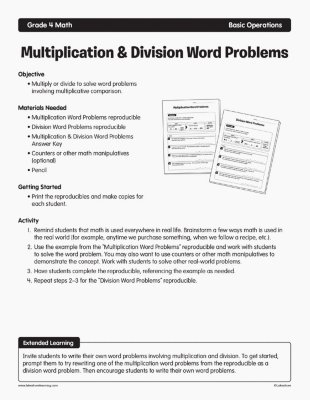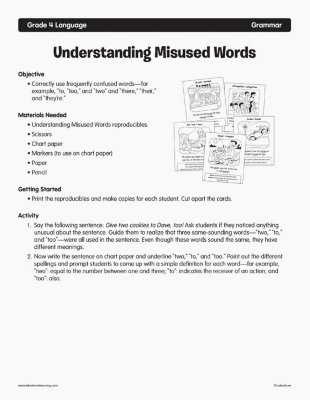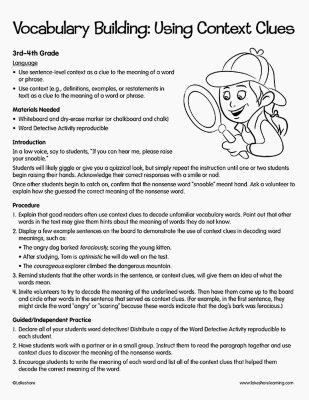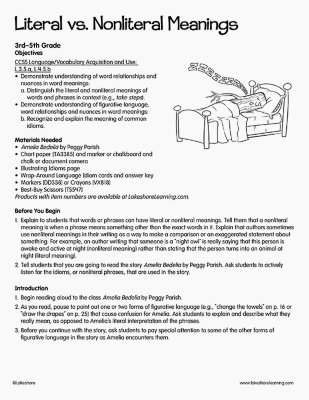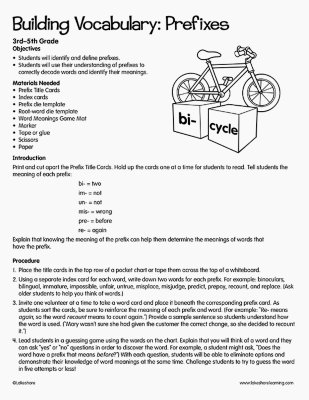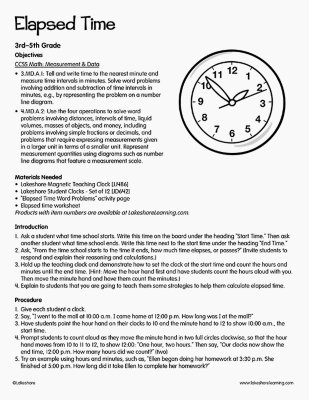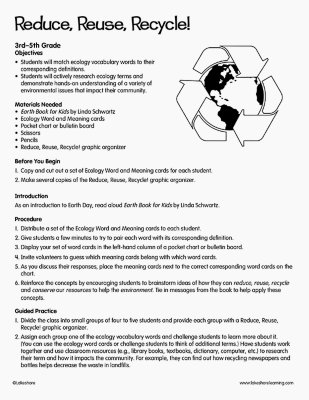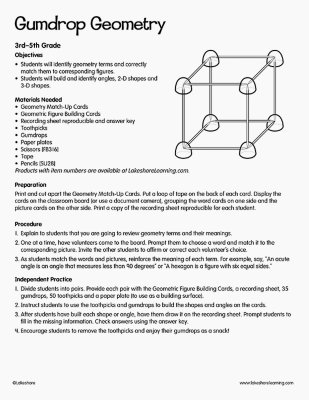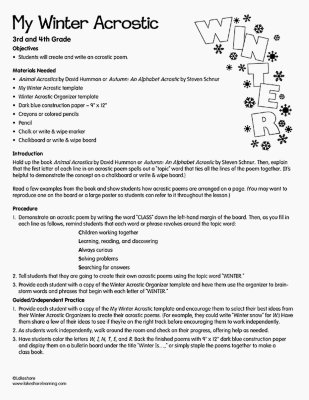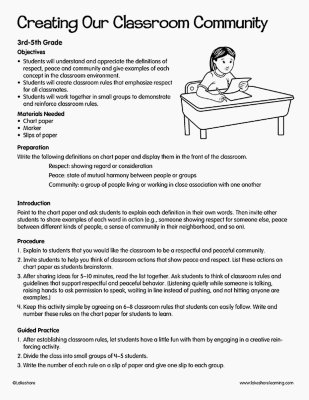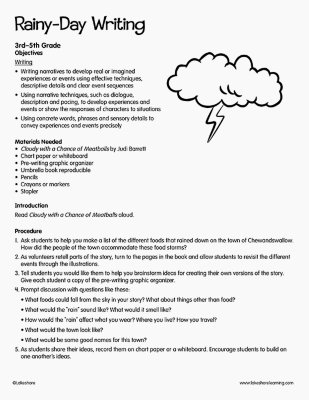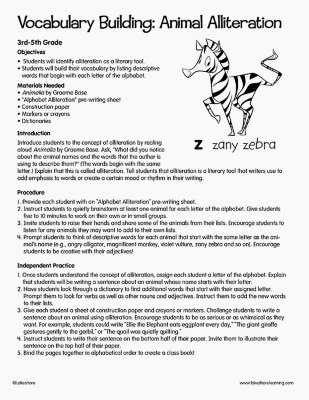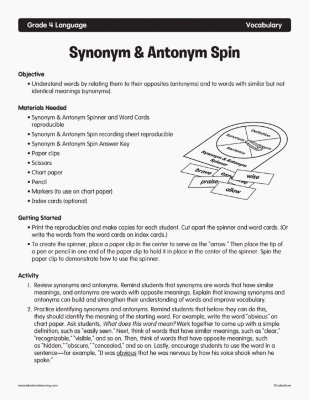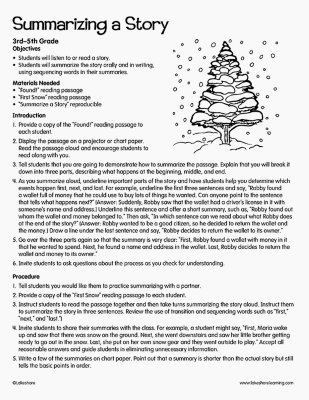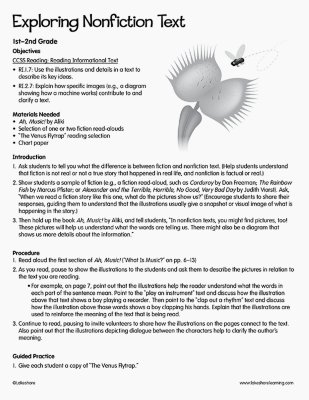Narrow by Grade
- Infant (1)
- Toddler (3)
- Preschool (0)
- Pre-K (14)
- Kindergarten (20)
- 1st (19)
- 2nd (18)
- 3rd (16)
- 4th (17)
- 5th (7)
- 6th & Up (0)
Grade 4th
Narrow by Age
- 0-18m (0)
- 18-36m (0)
- 3 yrs. (0)
- 4 yrs. (0)
- 5 yrs. (0)
- 6 yrs. (0)
- 7 yrs. (0)
- 8 yrs. (10)
- 9 yrs. (17)
- 10 yrs. (3)
- 11 yrs. & Up (0)
Age
17 results for "word"
Filters
Clear All
Multiplication & Division Word Problems
4th Grade
Objective
- Multiply or divide to solve word problems involving multiplicative comparison.
Understanding Misused Words
4th Grade
Objective
- Correctly use frequently confused words—for example, “to, “too,” and “two” and “there,” “their,” and “they’re.”
Vocabulary Building: Using Context Clues
3rd Grade - 4th Grade
Objectives Language Use sentence-level context as a clue to the meaning of a word or phrase. Use context (e.g., definitions, examples, or restatements in text) as a clue to the meaning of a word or phrase. Materials Needed Whiteboard and dry-erase marker (or chalkboard and chalk) Word Detective Activity reproducible Introduction In a low voice, say to students, “If you can hear me, please raise your snooble.” Students will likely giggle or give you a quizzical look, but simply repeat the instruction until one or two students begin raising their hands. Acknowledge their correct responses with a smile or nod. Once other students begin to catch on, confirm that the nonsense word “snooble” meant hand. Ask a volunteer to explain how she guessed the correct meaning of the nonsense word.
View Lesson PlanLiteral vs. Nonliteral Meanings
3rd Grade - 4th Grade
Objective CCSS Language/Vocabulary Acquisition and Use: L.3.5.a, L.4.5.b Demonstrate understanding of word relationships and nuances in word meanings: a. Distinguish the literal and nonliteral meanings of words and phrases in context (e.g., take steps). Demonstrate understanding of figurative language, word relationships and nuances in word meanings: b. Recognize and explain the meaning of common idioms. Materials Needed Amelia Bedelia by Peggy Parish Chart paper and marker or chalkboard and chalk or document camera Illustrating Idioms page Wrap-Around Language Idiom cards and answer key Markers or Crayons Best-Buy Scissors Before You Begin Explain to students that words or phrases can have literal or nonliteral meanings. Tell them that a nonliteral meaning is when a phrase means something other than the exact words in it. Explain that authors sometimes use nonliteral meanings in their writing as a way to make a comparison or an exaggerated statement about something. For example, an author writing that someone is a “night owl” is really saying that this person is awake and active at night (nonliteral meaning) rather than stating that the person turns into an animal at night (literal meaning). Tell students that you are going to read the story Amelia Bedelia by Peggy Parish. Ask students to actively listen for the idioms, or nonliteral phrases, that are used in the story. Introduction Begin reading aloud to the class Amelia Bedelia by Peggy Parish. As you read, pause to point out one or two forms of figurative language (e.g., “change the towels” on p. 16 or “draw the drapes” on p. 25) that cause confusion for Amelia. Ask students to explain and describe what they really mean, as opposed to Amelia’s literal interpretation of the phrases. Before you continue with the story, ask students to pay special attention to some of the other forms of figurative language in the story as Amelia encounters them.
View Lesson PlanBuilding Vocabulary: Prefixes
3rd Grade - 4th Grade
Objectives Identifying and knowing the meaning of the most common prefixes and derivational suffixes Determining the meaning of the new word formed when a known affix is added to a known word Using common, grade-appropriate Greek and Latin affixes and roots as clues to the meaning of a word Materials Needed Prefix title cards Index cards Prefix die template Root-word die template Word meanings game mat Marker Tape or glue Scissors Paper Pocket chart or whiteboard Introduction Print and cut apart the prefix title cards. Hold up the cards one at a time for students to read. Tell students the meaning of each prefix: bi- = two im- = not un- = not mis- = wrong pre- = before re- = again Explain that knowing the meaning of the prefix can help them determine the meanings of words that have the prefix.
View Lesson PlanElapsed Time
3rd Grade - 4th Grade
Objectives CCSS Math: Measurement & Data 3.MD.A.1: Tell and write time to the nearest minute and measure time intervals in minutes. Solve word problems involving addition and subtraction of time intervals in minutes, e.g., by representing the problem on a number line diagram. 4.MD.A.2: Use the four operations to solve word problems involving distances, intervals of time, liquid volumes, masses of objects, and money, including problems involving simple fractions or decimals, and problems that require expressing measurements given in a larger unit in terms of a smaller unit. Represent measurement quantities using diagrams such as number line diagrams that feature a measurement scale. Materials Needed Lakeshore Magnetic Teaching Clock Lakeshore Student Clocks - Set of 12 “Elapsed Time Word Problems” activity page Elapsed time worksheet Introduction Ask a student what time school starts. Write this time on the board under the heading “Start Time.” Then ask another student what time school ends. Write this time next to the start time under the heading “End Time.” Ask, “From the time school starts to the time it ends, how much time elapses, or passes?” (Invite students to respond and explain their reasoning and calculations.) Hold up the teaching clock and demonstrate how to set the clock at the start time and count the hours and minutes until the end time. (Hint: Move the hour hand first and have students count the hours aloud with you. Then move the minute hand and have them count the minutes.) Explain to students that you are going to teach them some strategies to help them calculate elapsed time.
View Lesson PlanReduce, Reuse, Recycle!
4th Grade
Objectives Students will match ecology vocabulary words to their corresponding definitions. Students will actively research ecology terms and demonstrate hands-on understanding of a variety of environmental issues that impact their community. Materials Needed Earth Book for Kids by Linda Schwartz Ecology Word and Meaning cards Pocket chart or bulletin board Scissors Pencils Reduce, Reuse, Recycle! graphic organizer Before You Begin Copy and cut out a set of Ecology Word and Meaning cards for each student. Make several copies of the Reduce, Reuse, Recycle! graphic organizer. Introduction As an introduction to Earth Day, read aloud Earth Book for Kids by Linda Schwartz.
View Lesson PlanMenu Math
3rd Grade - 4th Grade
Objectives CCSS Math: Operations & Algebraic Thinking 3.OA.D.8: Solve two-step word problems using the four operations. Represent these problems using equations with a letter standing for the unknown quantity. Assess the reasonableness of answers using mental computation and estimation strategies including rounding. 4.OA.A.3: Solve multistep word problems posed with whole numbers and having whole-number answers using the four operations, including problems in which remainders must be
View Lesson PlanGumdrop Geometry
4th Grade
Objectives Students will identify geometry terms and correctly match them to corresponding figures. Students will build and identify angles, 2-D shapes and 3-D shapes. Materials Needed Geometry Match-Up Cards Geometric Figure Building Cards Recording sheet reproducible and answer key Toothpicks Gumdrops Paper plates Scissors Tape Pencils Preparation: Print and cut apart the Geometry Match-Up Cards. Put a loop of tape on the back of each card. Display the cards on the classroom board (or use a document camera), grouping the word cards on one side and the picture cards on the other side. Print a copy of the recording sheet reproducible for each student.
View Lesson PlanMy Winter Acrostic
3rd Grade - 5th Grade
Objectives Reading: Literature Reading and comprehending grade-appropriate literature, including stories, dramas, and poetry Writing Writing an acrostic poem Materials Needed Animal Acrostics by David Hummon or Autumn: An Alphabet Acrostic by Steven Schnur My Winter Acrostic template Winter Acrostic Organizer template Dark-blue construction paper - 9" x 12" Crayons or colored pencils Pencil Chalk or write & wipe marker Chalkboard or write & wipe board Introduction Hold up the book Animal Acrostics by David Hummon or Autumn: An Alphabet Acrostic by Steven Schnur. Then explain that the first letter of each line in an acrostic poem spells out a “topic” word that ties all the lines of the poem together. (It’s helpful to demonstrate the concept on a chalkboard or write & wipe board.) Read a few examples from the book and show students how acrostic poems are arranged on a page. (You may want to reproduce one on the board or a large poster so students can refer to it throughout the lesson.)
View Lesson PlanCreating Our Classroom Community
3rd Grade - 5th Grade
Objectives Understanding and appreciating the definitions of respect, peace and community, and giving examples of each concept in the classroom environment Creating classroom rules that emphasize respect for all classmates Working together in small groups to demonstrate and reinforce classroom rules Describing people, places, things and events with relevant details, expressing ideas and feelings clearly Materials Needed Chart paper Marker Slips of paper Introduction Point to the chart paper and ask students to explain each definition in their own words. Then invite other students to share examples of each word in action (e.g., someone showing respect for someone else, peace between different kinds of people, a sense of community in their neighborhood).
View Lesson PlanClose Reading and Text Features
3rd Grade - 4th Grade
Objectives CCSS Reading: Informational Text RI.3.7: Use information gained from illustrations (e.g., maps, photographs) and the words in a text to demonstrate understanding of the text (e.g., where, when, why, and how key events occur). RI.4.7: Interpret information presented visually, orally, or quantitatively (e.g., in charts, graphs, diagrams, time lines, animations, or interactive elements on Web pages) and explain how the information contributes to an understanding of the text in which it appears. Materials Needed “Three Cheers for Engineers!” reading passage Paper and pencils Introduction Provide students with a copy of the “Three Cheers for Engineers!” reading passage. Tell students, “Today we are going to read a passage titled, “Three Cheers for Engineers!” One practice of good readers is that they pay close attention to the text. As we read, I want you to think about the meaning of the text, the words that are used and other features on the page that are used to help interpret the text.”
View Lesson PlanRainy-Day Writing
3rd Grade - 5th Grade
Objectives Writing Writing narratives to develop real or imagined experiences or events using effective techniques, descriptive details and clear event sequences Using narrative techniques, such as dialogue, description and pacing, to develop experiences and events or show the responses of characters to situations Using concrete words, phrases and sensory details to convey experiences and events precisely Materials Needed Cloudy with a Chance of Meatballs by Judi Barrett Chart paper or whiteboard Pre-writing graphic organizer Umbrella book reproducible Pencils Crayons or markers Stapler Introduction Read Cloudy with a Chance of Meatballs aloud.
View Lesson PlanVocabulary Building: Animal Alliteration
3rd Grade - 4th Grade
Objectives Students will identify alliteration as a literary tool. Students will build their vocabulary by listing descriptive words that begin with each letter of the alphabet. Materials Needed Animalia by Graeme Base “Alphabet Alliteration” pre-writing sheet Construction paper Markers or crayons Dictionaries Introduction Introduce students to the concept of alliteration by realing aloud Animalia by Graeme Base. Ask, “What did you notice about the animal names and the words that the author is using to describe them?” (The words begin with the same letter.) Explain that this is called alliteration. Tell students that alliteration is a literary tool that writers use to add emphasis to words or create a certain mood or rhythm in their writing.
View Lesson PlanSynonym & Antonym Spin
4th Grade
Objective
- Understand words by relating them to their opposites (antonyms) and to words with similar but not identical meanings (synonyms).
Summarizing a Story
4th Grade
Objectives Students will listen to or read a story. Students will summarize the story in writing, using sequencing words in their summaries. Materials Needed “Found!” reading passage “First Snow” reading passage “Summarize a Story” reproducible Introduction Provide a copy of the “Found!” reading passage to each student. Display the passage on a projector or chart paper. Read the passage aloud and encourage students to read along with you. Tell students that you are going to demonstrate how to summarize the passage. Explain that you will break it down into three parts, describing what happens at the beginning, middle, and end. As you summarize aloud, underline important parts of the story and have students help you determine which events happen first, next, and last. For example, underline the first three sentences and say, “Robby found a wallet full of money that he could use to buy lots of things he wanted. Can anyone point to the sentence that tells what happens next?” (Answer: Suddenly, Robby saw that the wallet had a driver’s license in it with someone’s name and address.) Underline this sentence and offer a short summary, such as, “Robby found out whom the wallet and money belonged to.” Then ask, “In which sentence can we read about what Robby does at the end of the story?” (Answer: Robby wanted to be a good citizen, so he decided to return the wallet and the money.) Draw a line under the last sentence and say, “Robby decides to return the wallet to its owner.” Go over the three parts again so that the summary is very clear: “First, Robby found a wallet with money in it that he wanted to spend. Next, he found a name and address in the wallet. Last, Robby decides to return the wallet and money to its owner.” Invite students to ask questions about the process as you check for understanding.
View Lesson PlanExploring Nonfiction Text
4th Grade
Objectives CCSS Reading: Reading Informational Text RI.1.7: Use the illustrations and details in a text to describe its key ideas. RI.2.7: Explain how specific images (e.g., a diagram showing how a machine works) contribute to and clarify a text. Materials Needed Ah, Music! by Aliki Selection of one or two fiction read-alouds “The Venus Flytrap” reading selection Chart paper Introduction Ask students to tell you what the difference is between fiction and nonfiction text. (Help students understand that fiction is not real or not a true story that happened in real life, and nonfiction is factual or real.) Show students a sample of fiction (e.g., a fiction read-aloud, such as Corduroy by Don Freeman; The Rainbow Fish by Marcus Pfister; or Alexander and the Terrible, Horrible, No Good, Very Bad Day by Judith Viorst). Ask, “When we read a fiction story like this one, what do the pictures show us?” (Encourage students to share their responses, guiding them to understand that the illustrations usually give a snapshot or visual image of what is happening in the story.) Then hold up the book Ah, Music! by Aliki, and tell students, “In nonfiction texts, you might find pictures, too! These pictures will help us understand what the words are telling us. There might also be a diagram that shows us more details about the information.”
View Lesson Plan